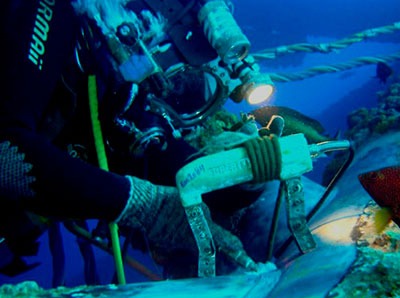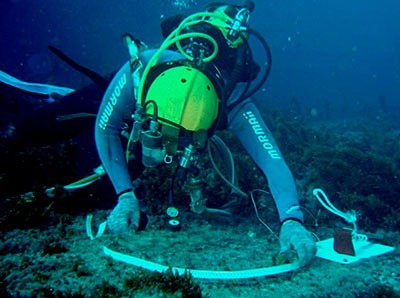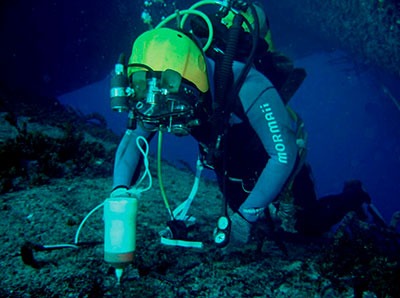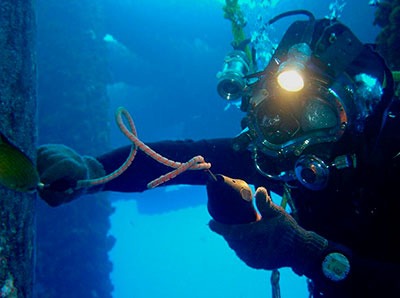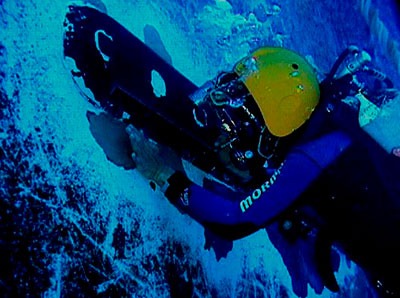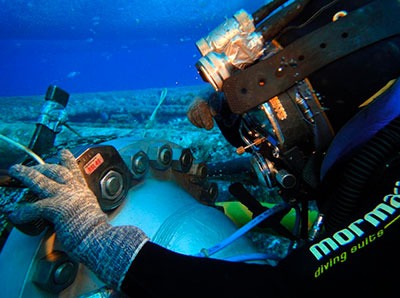Diving Services
Diving Services
Formed by experienced professional divers, our team is qualified to perform a wide variety of underwater inspections and the most complex underwater repair and maintenance services.
Learn about our range of diving services below, which will maximize your uptime during your contract and minimize downtime during unplanned shutdowns.
Non-destructive testing - Magnetic Particle – Underwater inspection
Magnetic Particle Testing is one of the most important activities of underwater inspection. The main objective of the technique is to detect superficial and subsurface linear discontinuities (fatigue cracks) that may appear on the welds connecting the various components of an oceanic structure, due to cyclic efforts that develop in these areas. The test uses a homogeneous magnetic field (magnetic flux lines) to examine the equipment and thus detect the discontinuities.
Non-destructive testing - Visual Inspection – Underwater inspection
Underwater visual inspection is a subjective technique, performed with the use of sight, in order to detect visible discontinuities and project nonconformities. The basic need for visual inspection is to ensure that a facility or equipment can perform its functions correctly and safely. To that end, it is necessary to inspect all its components and accessories on a regular basis. It is widely used in certification processes for offshore platforms, providing support to Classification Societies, as well as in the inspection of offshore oil and gas exploration, production, and offloading systems.
Visual testing can be carried out through direct or remote methods. In direct testing, the test is performed with the naked eye or with the aid of corrective lenses with direct observation of the surface to be inspected. In the remote method, the test is performed with the aid of optical devices.
Non-destructive testing - Ultrasound – Measurement of thickness for underwater inspection
The ultrasonic test is based on the sound waves reflection when they hit the separation surface of two media with different acoustic properties (acoustic impedance, density, sound speed, etc.). The ultrasonic waves are used with the objective of measuring the effects of corrosion and/or erosion on a metallic surface, also verifying the structure conditions in relation to the project.
Non-destructive testing - Electrochemical Potential Measurement – Underwater inspection
When installing a cathodic protection system on a marine unit, it is extremely important to know whether it is really protected against corrosion throughout its entire length. The most widely used and accepted method is the electrochemical potential measuring between the structure and the surrounding electrolyte (salt water), measured with a reference. With the use of a BathyCorrometer® equipment, it is possible to monitor the efficiency of the process, thus allowing corrections to be made when necessary.
Pull-In and/or Pull-Out Support
Pull-in and pull-out operations consist of several maneuvers performed between a Stationary Production Unit (SPU) and a Pipe-Laying Support Vessel (PLSV). These operations are performed always preceded by mobilization and preparation of the pulling systems (main winch – pull-in machine – and auxiliary winches). These maneuvers are performed to interconnect wells, subsea manifolds and import or export flow systems, through the transfer of flexible or rigid risers, from the PLSV to the SPU, in case of pull-in, and from the SPU to the PLSV, in case of pull-out.
Underwater Structures Assembly
Metrology for manufacturing of structural elements and templates, installation and removal of underwater structures, execution of submerged concreting and other activities, which enable/facilitate the exploration process of oil and its by-products.
Cathodic protection system Installation and Removal
Corrosive processes cause undesirable changes that are highly detrimental to any equipment. When this equipment is in a harsh environment, such as saltwater, corrosion has a significant effect on the integrity of these installations. Any material premature deterioration at an offshore units can affect their service life or create stress concentration points that could lead to material fatigue, causing extensive material damage or irreparable accident. To protect these marine installations from corrosive processes, cathodic protection (galvanic or impressed current) is used on the submerged part of the structure. Cathodic protection inhibits corrosive processes by injecting electric current into the structure through the electrolyte.
Surfaces Manual and Mechanical Cleaning
The requirement to clean a surface and the cleaning method are determined by the type of work that will be developed on it. According to the work to be performed, the area to be cleaned, and the degree of weathering of the surface, the underwater inspector must choose the most appropriate cleaning method and the necessary tools.
Rigid Riser
One of the nonconformities that may be found in the inspection of submarine risers is the presence of free spans, which is characterized by gaps between two natural or artificial supporting points in which the riser does not touch the seabed. In that case, the riser may suffer tension and stress, especially if there are welded joints, which can lead to the roser fatigue. The purpose of the work is to adequately support the riser by eliminating stress points. What will determine whether a free span must be supported or not are the technical characteristics of the line (diameter, type of coating, weight, transported fluid, etc.)
Shore End (Cable)
It is a service of preparation of the area where optical fiber and/or other types of cables will be launched, from the launching vessel to the shore, with the use of split-pipes and subsequent recomposition of the launching point, where the cables in the submerged areas and beaches are buried.
Coating Application
Subsea curing epoxy coating is widely used to coat fully submerged metal surfaces or in tidal and splash zones, when the paint coating has been damaged. It is also used for corrective maintenance of the dielectric shielding that is applied around the impressed current anodes. In some specific cases, it can be used to seal structural damage (fatigue cracking, for example) on offshore units.
Hyperbaric Welding
Underwater welding is one of the most interesting techniques for repair and installation of components in maritime structures, mainly due to its quick mobilization and simplicity. In Brazil it has been successfully used in the oil and gas industry (installation and reinstallation of sacrificial anodes, welding of lugs, clamp fixing, repair of fatigue cracks, etc.) and has aroused much interest in ship repairs from the perspective of cost reduction, avoiding the docking of the vessel. Continental, through its groundbreaking role in this technique, has been qualifying and training its welders and developing repair works for fatigue cracks on Petrobras’s offshore units.
Cutting, Roughing and Milling
In underwater inspection and maintenance work in marine installations, the diver is often required to use hydraulic tools to perform cutting, thinning, and milling of parts and surfaces, whether in the installation of structural components or even in the elimination of surface fatigue cracks.
Flexible Riser Repair
Flexible risers are used by production and flow units to transport fluids (oil, gas, water, etc.) at high or low pressure and at varying temperatures. These risers are periodically inspected for damage to the outer coating layer. These damages can quickly compromise the structure due to corrosion or by continuing abrasion in unit structures, compromising the internal reinforcement.
To prevent corrosion from compromising the internal reinforcement of the line, two techniques are used to seal the area where the external layer is damaged and exposes the tensile reinforcement. This corrective maintenance technique is used in flexible risers that present damage to their external layer, exposing the tensile armor, and the agent that caused the damage is no longer in place. The second technique is used in cases where the agent that caused the damage cannot be removed and is still acting on the flexible riser, such as FWD and AFT members at semi-submersible units, pontoon internal side-shell bracing of a jacket, etc.
Preventive and Corrective Maintenance in Sea Chests and Overboards
Sea chest is an underwater opening on the hull of maritime units for the supply of sea water to cool engines, feed the firefighting system, and to discharge water from various systems. Its proper functioning is therefore essential for the routine tasks and safety of the unit.
Scrap Removal
During inspection of maritime units, it is common to detect the presence of scrap in contact with the metallic surface of these units. Falling of scraps on the submerged components units can cause several types of mechanical damage, such as tears, cuts, warp, and denting. In addition to these damages, scrap metal in direct contact with the metallic part of the structure can interfere with the protection currents generated by the cathodic protection system of the facility. This is why any scrap must be removed.
Mooring, Connection, Disconnection and Untying of Ships and Monobuoys
Buoys are floating ocean terminals used to transfer production from a maritime unit, a manifold or even a single underwater well to a shuttle tanker or to transfer production from a shuttle tanker to a terminal on dry land. Several services are performed on buoys: mooring, connection, disconnection and unmooring of tankers; inspection of submerged components (anchoring system, structure, catenary angle measurement, cathodic protection anodes inspection, etc.); PLEM installation, among others.
Hook-UP support
Installation, handling, tensioning and maintenance of anchoring systems are offshore hook-up activities. Our company has a highly specialized team (supervisors, winch operators, IRATA climbers, divers, coppersmiths, welders, and other assistants) and all equipment to perform this service in offshore units.
Formed by experienced professional divers, our team is qualified to perform a wide variety of underwater inspections and the most complex underwater repair and maintenance services.
Learn about our range of diving services below, which will maximize your uptime during your contract and minimize downtime during unplanned shutdowns.
Non-destructive testing - Magnetic Particle – Underwater inspection
Magnetic Particle Testing is one of the most important activities of underwater inspection. The main objective of the technique is to detect superficial and subsurface linear discontinuities (fatigue cracks) that may appear on the welds connecting the various components of an oceanic structure, due to cyclic efforts that develop in these areas. The test uses a homogeneous magnetic field (magnetic flux lines) to examine the equipment and thus detect the discontinuities.
Non-destructive testing - Visual Inspection – Underwater inspection
Underwater visual inspection is a subjective technique, performed with the use of sight, in order to detect visible discontinuities and project nonconformities. The basic need for visual inspection is to ensure that a facility or equipment can perform its functions correctly and safely. To that end, it is necessary to inspect all its components and accessories on a regular basis. It is widely used in certification processes for offshore platforms, providing support to Classification Societies, as well as in the inspection of offshore oil and gas exploration, production, and offloading systems.
Visual testing can be carried out through direct or remote methods. In direct testing, the test is performed with the naked eye or with the aid of corrective lenses with direct observation of the surface to be inspected. In the remote method, the test is performed with the aid of optical devices.
Non-destructive testing - Ultrasound – Measurement of thickness for underwater inspection
The ultrasonic test is based on the sound waves reflection when they hit the separation surface of two media with different acoustic properties (acoustic impedance, density, sound speed, etc.). The ultrasonic waves are used with the objective of measuring the effects of corrosion and/or erosion on a metallic surface, also verifying the structure conditions in relation to the project.
Non-destructive testing - Electrochemical Potential Measurement – Underwater inspection
When installing a cathodic protection system on a marine unit, it is extremely important to know whether it is really protected against corrosion throughout its entire length. The most widely used and accepted method is the electrochemical potential measuring between the structure and the surrounding electrolyte (salt water), measured with a reference. With the use of a BathyCorrometer® equipment, it is possible to monitor the efficiency of the process, thus allowing corrections to be made when necessary.
Pull-In and/or Pull-Out Support
Pull-in and pull-out operations consist of several maneuvers performed between a Stationary Production Unit (SPU) and a Pipe-Laying Support Vessel (PLSV). These operations are performed always preceded by mobilization and preparation of the pulling systems (main winch – pull-in machine – and auxiliary winches). These maneuvers are performed to interconnect wells, subsea manifolds and import or export flow systems, through the transfer of flexible or rigid risers, from the PLSV to the SPU, in case of pull-in, and from the SPU to the PLSV, in case of pull-out.
Underwater Structures Assembly
Metrology for manufacturing of structural elements and templates, installation and removal of underwater structures, execution of submerged concreting and other activities, which enable/facilitate the exploration process of oil and its by-products.
Cathodic protection system Installation and Removal
Corrosive processes cause undesirable changes that are highly detrimental to any equipment. When this equipment is in a harsh environment, such as saltwater, corrosion has a significant effect on the integrity of these installations. Any material premature deterioration at an offshore units can affect their service life or create stress concentration points that could lead to material fatigue, causing extensive material damage or irreparable accident. To protect these marine installations from corrosive processes, cathodic protection (galvanic or impressed current) is used on the submerged part of the structure. Cathodic protection inhibits corrosive processes by injecting electric current into the structure through the electrolyte.
Surfaces Manual and Mechanical Cleaning
The requirement to clean a surface and the cleaning method are determined by the type of work that will be developed on it. According to the work to be performed, the area to be cleaned, and the degree of weathering of the surface, the underwater inspector must choose the most appropriate cleaning method and the necessary tools.
Rigid Riser
One of the nonconformities that may be found in the inspection of submarine risers is the presence of free spans, which is characterized by gaps between two natural or artificial supporting points in which the riser does not touch the seabed. In that case, the riser may suffer tension and stress, especially if there are welded joints, which can lead to the roser fatigue. The purpose of the work is to adequately support the riser by eliminating stress points. What will determine whether a free span must be supported or not are the technical characteristics of the line (diameter, type of coating, weight, transported fluid, etc.)
Shore End (Cable)
It is a service of preparation of the area where optical fiber and/or other types of cables will be launched, from the launching vessel to the shore, with the use of split-pipes and subsequent recomposition of the launching point, where the cables in the submerged areas and beaches are buried.
Coating Application
Subsea curing epoxy coating is widely used to coat fully submerged metal surfaces or in tidal and splash zones, when the paint coating has been damaged. It is also used for corrective maintenance of the dielectric shielding that is applied around the impressed current anodes. In some specific cases, it can be used to seal structural damage (fatigue cracking, for example) on offshore units.
Hyperbaric Welding
Underwater welding is one of the most interesting techniques for repair and installation of components in maritime structures, mainly due to its quick mobilization and simplicity. In Brazil it has been successfully used in the oil and gas industry (installation and reinstallation of sacrificial anodes, welding of lugs, clamp fixing, repair of fatigue cracks, etc.) and has aroused much interest in ship repairs from the perspective of cost reduction, avoiding the docking of the vessel. Continental, through its groundbreaking role in this technique, has been qualifying and training its welders and developing repair works for fatigue cracks on Petrobras’s offshore units.
Cutting, Roughing and Milling
In underwater inspection and maintenance work in marine installations, the diver is often required to use hydraulic tools to perform cutting, thinning, and milling of parts and surfaces, whether in the installation of structural components or even in the elimination of surface fatigue cracks.
Flexible Riser Repair
Flexible risers are used by production and flow units to transport fluids (oil, gas, water, etc.) at high or low pressure and at varying temperatures. These risers are periodically inspected for damage to the outer coating layer. These damages can quickly compromise the structure due to corrosion or by continuing abrasion in unit structures, compromising the internal reinforcement.
To prevent corrosion from compromising the internal reinforcement of the line, two techniques are used to seal the area where the external layer is damaged and exposes the tensile reinforcement. This corrective maintenance technique is used in flexible risers that present damage to their external layer, exposing the tensile armor, and the agent that caused the damage is no longer in place. The second technique is used in cases where the agent that caused the damage cannot be removed and is still acting on the flexible riser, such as FWD and AFT members at semi-submersible units, pontoon internal side-shell bracing of a jacket, etc.
Preventive and Corrective Maintenance in Sea Chests and Overboards
Sea chest is an underwater opening on the hull of maritime units for the supply of sea water to cool engines, feed the firefighting system, and to discharge water from various systems. Its proper functioning is therefore essential for the routine tasks and safety of the unit.
Scrap Removal
During inspection of maritime units, it is common to detect the presence of scrap in contact with the metallic surface of these units. Falling of scraps on the submerged components units can cause several types of mechanical damage, such as tears, cuts, warp, and denting. In addition to these damages, scrap metal in direct contact with the metallic part of the structure can interfere with the protection currents generated by the cathodic protection system of the facility. This is why any scrap must be removed.
Mooring, Connection, Disconnection and Untying of Ships and Monobuoys
Buoys are floating ocean terminals used to transfer production from a maritime unit, a manifold or even a single underwater well to a shuttle tanker or to transfer production from a shuttle tanker to a terminal on dry land. Several services are performed on buoys: mooring, connection, disconnection and unmooring of tankers; inspection of submerged components (anchoring system, structure, catenary angle measurement, cathodic protection anodes inspection, etc.); PLEM installation, among others.
Hook-UP support
Installation, handling, tensioning and maintenance of anchoring systems are offshore hook-up activities. Our company has a highly specialized team (supervisors, winch operators, IRATA climbers, divers, coppersmiths, welders, and other assistants) and all equipment to perform this service in offshore units.
Do you have a project in mind?
Get in touch below and let us exceed your expectations.



